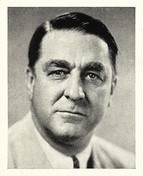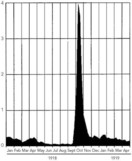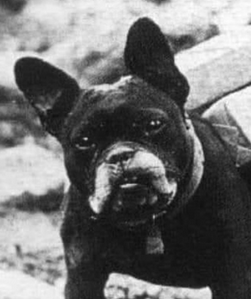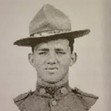Countdown: 100 Days to Bells of Peace runs August 4 to November 11, 2020
Announcing Bells of Peace, A World War I Remembrance, November 11, 2020, when everyone is invited to toll the “Bells of Peace” in honor of all those who served and sacrificed in World War I. To kickoff “Bells of Peace,” on August 4, 2020, join us for a “100-Day Countdown” to November 11, 2020 on our social media platforms Facebook, Twitter and Instagram. The “100-Day Countdown” features stories commemorating the 100-day offensive on the Western Front leading up to WWI Armistice, November 11, 1918 when the guns fell silent and the bells tolled on the Western Front, at the 11th hour of the 11th day of the 11th month. Click here to read more about the Countdown, and learn how you, your family and friends, your organizations, and your communities can toll the “Bells of Peace” and remember this pivotal moment in our Nation’s history and all those who served in World War I.
WWI Hero in new AUSA Graphic Novel

Branch Rickey was an Army officer in the Chemical Warfare Service during WWI. In his unit, coincidentally, were future baseball greats Ty Cobb and Christy Mathewson. Rickey would also take a place in baseball history, thanks to his decision to do the right thing. In October 1945, as general manager of the Brooklyn Dodgers, Rickey signed infielder Jackie Robinson, an African American, for the Dodgers' minor league team. Robinson's later success with the Dodgers from 1947 to 1956 led other owners to seek Black talent. Click here to read more about RIckey's great service to the nation in war and peace.
|

Writing a decade ago for the Public Health Reports at the National Institutes of Health, researcher Carol Byerly took a hard look at how "The American military experience in World War I and the influenza pandemic were closely intertwined." The pandemic "sickened 20% to 40% of U.S. Army and Navy personnel" with highly deleterious effects on induction, training, and availability of military personnel. She notes that "During the American Expeditionary Forces' campaign at Meuse-Argonne, the epidemic diverted urgently needed resources from combat support to transporting and caring for the sick and the dead." Click here to read the entire article, and learn more about the 1918 pandemic, and lessons we can take way a century later from the military's response.
|

Outdoor events allowing for social distancing are among the August offerings from the National WWI Museum and Memorial. The Summer Movie Series returns on Friday, Aug. 13 with a screening of the ground-breaking film They Shall Not Grow Old from Oscar-winner Peter Jackson. Guests can come together on Saturday, Aug. 29 from 5-8:15 p.m. for the socially-distanced Jazz on the Lawn: A Modern Picnic. The event celebrates the spirit of the early 1920s with the hottest jazz band in town, Grand Marquis, as well as former Mayor Sly James and DJ Hartzell Gray. Rounding out the slate of outdoor events is the annual program Living the Great War from 10 a.m. – 5 p.m. on Saturday, Aug. 29. This free program features the Living History Volunteer Corps and vehicles from the Military Vehicle Preservation Association. Click here to read more about these and other August activities at the National WWI Museum and Memorial, and how to sign up to attend.
|

On July 28th in 1918, President Woodrow Wilson gave the order to fly the flag of Serbia over the White House. This was one of a number of acts that reflected the solidarity of Americans with the Serbian people who suffered so tremendously during the First World War. At the start of the conflict, thousands of young Americans of Serbian descent volunteered to cross the Atlantic and fight shoulder-to-shoulder with their cousins. Malvina Hoffmann’s famous poster urged people to make donations to assist the people of Serbia. Pupin, Mabel Grujić, and others collected not only money, but also thousands of tons of humanitarian aid for the poor and for displaced refugees from Serbia. Click here to read more about American assistance to Serbia during and after World War I.
|

In 1932, some 25,000 World War I veterans descended on Washington, DC to to demand that the government keep its word about an early payment of a bonus they had been promised following victory in the First World War. On July 19 of that year, retired Marine Maj. Gen. Smedley Butler took to the stage at the largest so-called Bonus Army camp in the Anacostia Flats area outside of downtown D.C. There he launched into a fiery tirade that remains relevant to military veterans, and Americans at large, even to this day. Click here to read more about Butler's speech, and why it remains pertinent and important almost eighty years later.
|

During World War I, a plethora of “good boys” and dog breeds participated in tasks that would be deemed unusual in today’s modern wars. Among them were dogs who pulled carts with machine guns on the other end, while others hauled supplies. Bruce, a black-and-white British companion, acted as a messenger running urgent orders up and down the Western Front. Rats were a nuisance in the muddy trenches and were so prevalent that the French trained smaller dogs as rat-catchers. Mutt, a French Bulldog (left) belonging to the YMCA Cigarette Dog delivery service, was wounded twice while trying to improve the morale of soldiers in the 11th Engineers. Click here to read more about the many animals (many of surprising species) who made their mark serving American and other forces in World War I.
|

A man is only missing if he is forgotten.
Our Doughboy MIA this month is Private Samuel J. Hochfelder of Company L/106th Infantry Regiment/27th Division.
Hochfelder was born in January, 1899 to Louis and Rose Hochfelder, Hungarian immigrants. He was one of five children and was born in the Bronx, New York. Following America's declaration of war, Samuel joined the army on June 7th, 1917 and was first assigned to the 23rd Infantry Regiment, New York National Guard. The 23rd was later federalized as the 106th Infantry. With them he went to France aboard the USS President Lincoln on May 10th, 1918.
In France the 27th Division was one of two divisions brigaded with the British as the US 2nd Corps, fighting in the British sector. The 106th first moved into the lines on June 25th, 1918 in Belgium, distinguishing itself in combat. On September 1st, 1918, the 106th Infantry was engaged in heavy action in the midst of the Ypres-Lys Offensive. About 10:00 am that morning, in the midst of a heavy artillery barrage, Hochfelder was hit directly by an artillery shell and was reported "mutilated beyond recognition". His comrades had no time to bury him properly and thus his remains were pulled into a nearby shell hole. Unfortunately his grave was never found.
Even with Covid upon us, we continue to research our missing Doughboys and need your help! Please consider giving 'Ten For Them' - make a donation of just $10.00 to Doughboy MIA and know that you did your part toward making as full accounting as possible of our missing soldiers, sailors, airmen, and Marines from the Great War. Visit www.ww1cc.org/mia and make your tax deductible donation to our non-profit organization today. And remember:
A man is only missing if he is forgotten.
|
|